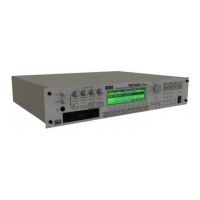86
3 The editing range will be shown in Range “Start” and
“End.”
4 Use “Truncate” to select the portion that will be deleted.
Front & End: The sample data that lies before the “S (Edit
Range Start)” and after the “E (Edit Range End)” will be
deleted.
Front: The sample data that lies before the “S (Edit Range
Start)” will be deleted.
End: The sample data that lies after the “E (Edit Range
End)” will be deleted.
5 In “Save to No.,” specify the save destination sample
number. By default, an unused sample number will be
selected. If you have checked “Overwrite,” this cannot be
set.
For a stereo sample, “Save to No.(L)” and “(R)”
will be displayed. Specify the save destination sample
number for the L channel and R channel respectively.
6 If you wish to delete the original sample data and over-
write it with the edited sample data, check “Overwrite”.
Normally, you will leave “Save to No.” at its default set-
ting, and execute without checking “Overwrite.” (
☞p.85
“*”: About “Overwrite”)
7 To execute the Truncate command, press the [F8] (“OK”)
key. To cancel, press the [F7] (“Cancel”) key.
Cut
This command deletes the data between the “S (Edit Range
Start)” and “E (Edit Range End).” Sample data located after
the deleted portion will be moved forward.
1 Use “SMPL” (2.1–1a) to select the sample that you wish
to edit, and use “S (Edit Range Start)” and “E (Edit Range
End)” (2.1–1b) to specify the editing range.
You can press the [AUDITION] key to hear the portion
that will be deleted by the “Cut” command.
2 Select “Cut” to open the following dialog box.
3 The range to be edited is shown by Range “Start” and
“End.”
4 In “Save to No.,” specify the save destination sample
number. By default, an unused sample number will be
selected. If you have checked “Overwrite,” this cannot be
set.
For a stereo sample, “Save to No.(L)” and “(R)”
will be displayed. Specify the save destination sample
number for the L channel and R channel respectively.
5 If you wish to delete the original sample data and over-
write it with the edited sample data, check “Overwrite”.
Normally, you will leave “Save to No.” at its default set-
ting, and execute without checking “Overwrite.” (
☞p.85
“*”: About “Overwrite”)
6 To execute the Cut command, press the [F8] (“OK”) key.
To cancel, press the [F7] (“Cancel”) key.
Clear
This command converts the data between “S (Edit Range
Start)” and “E (Edit Range End)” to zero values. Sample
data before and after the edited range will not move.
1 Use “SMPL” (2.1–1a) to select the sample that you wish
to edit, and use “S (Edit Range Start)” and “E (Edit Range
End)” (2.1–1b) to specify the editing range.
You can press the [AUDITION] key to hear the portion
that will be changed to zero-level by the “Clear” com-
mand.
2 Select “Clear” to open the following dialog box.
3 The range to be edited is shown by Range “Start” and
“End.”
4 In “Save to No.,” specify the save destination sample
number. By default, an unused sample number will be
selected. If you have checked “Overwrite,” this cannot be
set.
For a stereo sample, “Save to No.(L)” and “(R)”
will be displayed. Specify the save destination sample
number for the L channel and R channel respectively.
5 If you wish to delete the original sample data and over-
write it with the edited sample data, check “Overwrite”.
Normally, you will leave “Save to No.” at its default set-
ting, and execute without checking “Overwrite.” (
☞p.85
“*”: About “Overwrite”)
6 To execute the Clear command, press the [F8] (“OK”)
key. To cancel, press the [F7] (“Cancel”) key.
Normally you will leave “Save to No.” at the default
setting, and execute without checking “Overwrite.”
When you execute, the original data and the edited data
will both be preserved, and the sample number after
editing will be assigned to the sample of the index.
Copy
This command copies the sample data from the area
between “S (Edit Range Start)” and “E (Edit Range End)”
into the sample data buffer. This data can then be used by
the “Insert,” “Mix” or “Paste” commands.
When “Copy” is executed, the data that is loaded into the
buffer simply references the data of the original sample.
After using “Copy,” do not delete the copy source sample
until you “Insert,” “Mix” or “Paste” the copied data.
1 Use “SMPL” (2.1–1a) to select the sample that you wish
to edit, and use “S (Edit Range Start)” and “E (Edit Range
End)” (2.1–1b) to specify the editing range.
You can press the [AUDITION] key to hear the portion
that will be copied by the “Copy” command.

